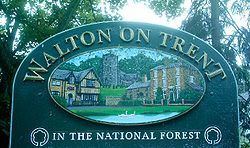OS grid reference SK216180 Post town SWADLINCOTE Postcode district DE12 | Sovereign state United Kingdom Population 872 (2011) | |
 | ||
Walton-on-Trent is a parish and village in the National Forest in Derbyshire, England. The population of the civil parish as taken at the 2011 Census was 872. As its name implies it is an ancient crossing point of the River Trent. It was at this point that King Edward II crossed the river in pursuit of the disaffected barons including the Earl of Lancaster. Listed buildings in the parish include Catton Hall and Walton Hall. Today the town is situated almost exactly midway between Birmingham and Derby.
Contents
Map of Walton-on-Trent, Swadlincote, UK
The name Walton comes from settlement/farmstead of Wealas - native Celts which is what the new Anglo Saxon speaking peoples called the native inhabitants of England. There is strong evidence that in many areas of England taken over by Germanic speaking settlers, the native British (Wealas) remained undisturbed, farming the same land they did when the Romans left. Over time they just adopted or forgot their Celtic tongue (similar to Old Welsh/Cornish) for the language and culture of the newcomers in order to climb the social ladder or were coerced to do so. It was in the Anglo Saxon interest that the native British carry on as usual to ensure the economy produced food and goods for the new landowners.
The Bridge at Walton
The original bridge was built in 1834 and lasted for over one hundred years before being replaced in 1948 by a temporary Bailey bridge. This was erected by the Royal Engineers over the top of the old bridge, part of which was removed to allow a support to be built on the Staffordshire bank of the river, the temporary bridge had to be built due to flood damage to the old bridge after the severe winter of 1947. This bridge had to again be replaced in 1974 by a more modern version of the temporary bridge. The old bridge was a toll bridge for many years and pictures of the "old bridge" and the toll house are still available.
The Church
St Lawrence's Church, Walton-on-Trent church proudly boasts its founding as “c.1000” on the sign by its Lytchgate. At about that time it would have been in the ownership of Aelfgar, an Anglo-Saxon who also had interests which included manors at Weston-on-Trent, Newton Solney and Repton. It is his name that is given as the former owner of Walton-on-Trent's church, mill, 40 acres (160,000 m2) of meadow and 35 square furlongs of pasture when the new king took them as part of his personal reward for winning the English crown.
The village has a Church of England school.
Catton Hall
Catton Hall gives its postal address as Walton on Trent although there was a village of Catton at one time. Catton Hall is owned by the Neilson family, descendants of Anson-Horton family, who themselves were descendants of the Fifth Baronet, Rev. Sir George Wilmot-Horton. The Hall is now available for private functions and horse trials. The hall has been there since the 15th century but the current building was founded in 1745. Annually, Catton Hall hosts heavy metal festival Bloodstock Open Air featuring prominent bands such as Children of Bodom, Opeth, and Nightwish.
